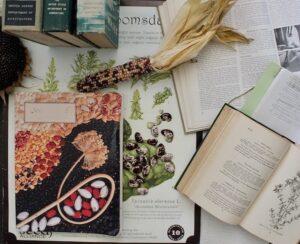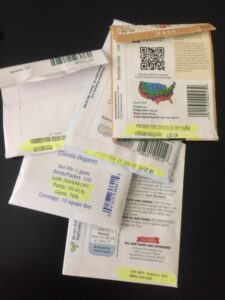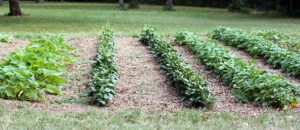Seed Saving Blog

Seed Bunchers or Seed Folders
Are you a buncher or a folder? An online article claims that you can tell a lot about a person by the way they handle their toilet paper. According to the author, folders tend to be detail oriented and intentional in their actions. They like to plan and are methodical. Folders are willing to spend a few extra seconds to fold the paper for the most efficient use.
Bunchers, on the other hand, are more spontaneous. They tend to see the big picture and trust that the details will fall into place naturally. In the bathroom, bunchers’ minds go back and forth, and they are in a hurry to get on with their day.
What can toilet paper styles tell us about approaches to seed saving? Folders may be those who keep all their seed varieties true to type, planting only one cultivar, since those are the rules. They may keep distances between crops to prevent cross-pollination, use population numbers to assure good genetic diversity and they never use hybrids because the prevailing wisdom says that you can’t save seeds from hybrid plants.
How might bunchers approach seed saving? Where folders may be more linear and methodical, perhaps bunchers would be more creative, tossing many different varieties in a garden bed to see what happens. They may be less intentional. Instead of starting with a specific trait to promote, they may instead look for happy accidents that produce desirable traits randomly. They may be less likely to worry about weird outcomes and more hopeful that cross pollination may lead to crops that thrive against the odds or that yield the next new delicious butternut squash or sweet corn variety.
Okay, maybe comp aring toilet paper handling to seed saving is not the best introduction to seed saving myths, but I bet you are still reading!
aring toilet paper handling to seed saving is not the best introduction to seed saving myths, but I bet you are still reading!
According to Webster’s Dictionary, a myth is an idea or story that is believed by many people but that is not true. Seed saving myths are plentiful and often are motivated by large corporations to increase seed sales and profits. There is a whole arena of seed savers who espouse the “proper way” to handle this most natural of phenomena.
This school of thought embraces the following ideas: You can’t save seeds to hybrids. You need lots of chemical inputs to grow successful seed crops. Seed saving is hard and should not be attempted by amateurs. You need a lot of space to save seeds.
Just as categorizing people by their toilet paper habits is simplistic and does not apply across the board, conventional seed saving rules do not tell the whole story. There are many approaches to seed saving that do not fit the mold.
Of course, there is a grain of truth to the myths that apply to farmers and gardeners who sell produce or seeds. In commercial applications, the “rules” help to maintain uniformity.
But for your average backyard gardener, seed saving does not have to be complicated or technical. First of all, getting started is easier than you might believe. And you don’t need a degree to do it, just a little bit of know-how. For example, there are a handful of crops that are self-pollinating, so you don’t have to worry about them crossing with others. Just let them go to seed and harvest! Those crops include tomatoes, peppers, beans, peas and lettuce.
In the case of corn, if you plant more than one variety, then you may get an interesting mix of traits. This is where you get to experiment. Harvest the colors, textures or flavors that you like and plant again. Within a few seasons you will have your own signature corn crop.
Some crops are biennial, meaning they require two seasons to set seed. Examples of biennials are the brassicas, including cauliflower, mustards, broccoli, and many more. Once you know which varieties are biennial, let a few plants flower and then just wait! In due time you will be able to harvest more seeds than you can use in a lifetime (no large spaces needed.)
In terms of population numbers, space and distances between crops, there are general rules that support success. But again, learning your own regional idiosyncrasies and specifically your backyard climactic swings and exposures will help more in your success then following some boilerplate, one size fits all gardening or seed saving method.
Hybrid seed is another interesting row to hoe. It is not true that you can never save seeds to hybrids. Many seed savers are unaware that there is a process for de-hybridizing seeds by selecting out the genetics that you desire, such as drought tolerance or insect resistance. By doing so, within a few years you can recapture an original variety that “breeds true. “
 And finally, seed companies would have us tossing our expired seeds and buying fresh seeds every year. The truth is that properly stored seeds do not “go bad” very quickly and are often viable well past the expiration date. We (Belle and Bill) have 10-year-old seed and older that still germinates. The trick is making sure the seed is kept cool (below 80 degrees), dark and dry.
And finally, seed companies would have us tossing our expired seeds and buying fresh seeds every year. The truth is that properly stored seeds do not “go bad” very quickly and are often viable well past the expiration date. We (Belle and Bill) have 10-year-old seed and older that still germinates. The trick is making sure the seed is kept cool (below 80 degrees), dark and dry.
The best compendium on seed saving in our estimation is Bill McDorman’s Basic Seed Saving book available at Great American Seed Up. org (also available on Kindle). It is the simplest, shortest, most comprehensive and least expensive seed saving book in the market.
Beware of people, institutions and even “experts” who appear to have all the answers. Just as the toilet paper test does not tell you everything about people, no seed authority knows everything about seed saving. Ask questions, be good observers and bring a sense of exploration and playfulness to your garden. In the end, you’ll have more fun, experience less stress and feel a sense of accomplishment for being part of this amazing process.
The mission of the Great American Seed Up is to get seeds into the hands of gardeners and support the resilience of communities across the country. The heirloom seed varieties that we stock are easy to grow and suitable for seed saving. We love to hear about our customer’s gardens. And we are even more thrilled when they save seeds from the harvest to plant the next season. By doing so year after year, these gardeners may never need to buy seeds to those varieties again. And they will undoubtedly have plenty of extra seeds to share with others. GreatAmericanSeedUp.org
GASU seed bundles can be found here. Each bundle contains plenty of seed to grow, save and share amongst 10 or more gardeners.
If you happen to be in the Phoenix area, register to attend the Phoenix Seed Up on November 4th and 5th, 2022. This is a live, in-person event held in Phoenix, Arizona. Registration and more info can be found here.
Recent Posts
- 2023 SEED LIST – Phoenix Seed Up Event October 27-28
- Seed Resources: Navigating the Abundance of Knowledge
- Seed List for the Phoenix Seed Up Event November 4-5, 2022
- Your Personal Seed Bank: Doomsday Vault or Your Best Shot at an Abundant Future?
- What is the Great American Seed Up??
- HOME GARDENERS FACE SEED SHORTAGES
- What In the World is Happening with Grain?
- Grains in Gardens & Other Skills to Learn & Share
